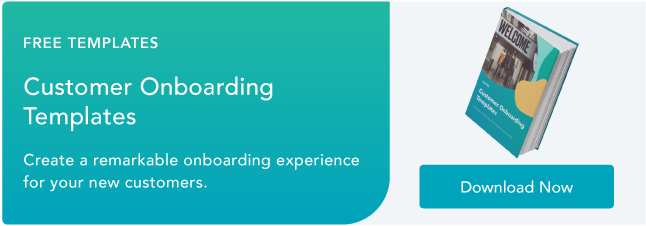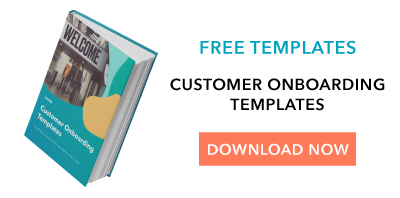Why is it important to follow customer onboarding best practices?
You've heard of the theory of evolution, right? Only the adaptable — not the strong — survive in this unpredictable world. The business world is no exception. Your company is an organism, and it needs sustenance to grow.
Customer onboarding is your sustenance. Following best practices in onboarding will help your company grow and expand, whereas choosing to stay the same in a changing business world will stall your company.
Following user onboarding best practices benefits you in the following ways:
It ensures customer success.
According to Sixteen Ventures, an onboarded customer is two things:
- One that has experienced "initial success" with your product
- One that sees the real value potential in their relationship with you
For Groove HQ, on a slightly different strain, a customer is onboarded 1) the moment they sign up, and 2) the moment they see success with your product. At any rate, you can think of an onboarded customer as simply this: one who is confident in your ability to get stuff done, because they've seen you do it.
It prevents churn.
As customer success thought leader, Lincoln Murphy, famously says, "the seeds of churn are planted early." In other words, they’re planted right after customers sign up with you — and maybe even before that, during the sales process. That’s why it’s so critical to create a stellar onboarding process.
Failing to follow onboarding best practices will take you down when churn hits you like a gigantic asteroid careening towards your little corporate planet. So, to make your company's environment inhospitable to the seeds of churn, it's essential to examine your onboarding practices and improve upon them.
It reinstates your product’s value.
Onboarding is a process, not a one-and-done action. It goes beyond the handshake not only to prove your value over and over, but also to sustain a meaningful, mutually beneficial relationship.
To that end, read on for evergreen customer onboarding best practices that apply to any industry.
Featured Resource: Customer Onboarding Templates
HubSpot's free Customer Onboarding Templates will help you create an onboarding process that's flexible, consistent, and effective. Click here to access them for free.
Customer Onboarding Best Practices
- Create a best-in-class customer onboarding program.
- Find the best customer onboarding software.
- Define expectations and set milestones.
- Customize the experience.
- Implement onboarding activities.
- Onboard your team, too.
- Gather data.
- Focus on the relationship.
- Communicate.
- Follow up after onboarding is complete.
- Continuously assess customer needs.
- Onboard product add-ons and account upgrades.
- Make your onboarding process accessible, flexible, and repeatable.
To get your customers acquainted with your products or services, it's necessary to implement best onboarding practices. Following the techniques listed below will equip you to create a seamless, engaging onboarding experience that can lead to happy, recurring customers.
1. Create a best-in-class customer onboarding program.
You can’t expect every customer to instantly know the ins and outs of using your products or services. When left to their own devices, they can easily become frustrated, and disgruntled customers can lead to a high churn rate, which refers to the percentage of customers that stop using your company’s products or services during a period. To keep your customer churn as low as possible, create a quality onboarding program.
Customer onboarding is a process that nurtures and proactively guides new customers through learning and using your products or services. This first step in building this relationship increases customer lifetime value. While it is more expensive to attract new customers than it is to focus on existing ones, this process has the potential to create an excellent and memorable experience for new customers. As they move through this process, this can increase your company’s perceived value in their minds and push them to be loyal, repeat customers in the future.
Additional benefits of a quality customer onboarding program include increased revenue, word-of-mouth referrals, decreased customer service costs, and increased engagement. Customer onboarding sets the tone for the ongoing relationship your customers will have with your products and business. Here you will find onboarding ideas to help get your customers acquainted with your brand.
2. Find the best customer onboarding software.
Once your company has plans to create an onboarding program, you will need to find the right software to suit your needs. These programs give you the tools to create in-app onboarding, and onboarding videos while measuring engagement with your customers. These tools can translate into welcome email series, product tours, video tutorials, and more.
Customer onboarding software currently available includes WalkMe, Apty, Whatfix, Userpilot, and Chameleon.
3. Define expectations and set milestones.
I'm a huge advocate of asking as many questions as possible, but this is especially important in the first few days and weeks of engagement with your customers. The biggest question to answer is this: How do they define success? In the new age of customer success, the word "success" is synonymous with the ultimate goal. That means defining what they want out of your engagement, or the so called, “desired outcome” among people in the SaaS customer success world. That will set the stage for setting the customer's expectations.
Next? Make a plan and make it happen. This will require setting "success milestones" — a fancy word for goal deadlines — and letting your customer define what those will look like during the sales process, no matter what it looks like in your industry.
Most importantly, be very real: make sure you’re setting milestones you can hit, accurately, every time.
4. Customize the experience.
There's a lot of stuff out on the web about customizing the onboarding experience for new employees that will make them feel at home. Treat your customers like you would do to a new, valuable employee. Consider your customer as a partner and make their onboarding experience specific to them and their needs.
Part of the onboarding experience should be individualizing each account, and that should be one of your standard protocols. What does individualizing the onboarding experience look like? Consider the principles of UX design: The experience with you, regardless of industry, should be valuable, useful, desirable, accessible, etc. That could range from creating client-only VIP portals, creating personal profiles, offering exclusive content, being readily available, and understanding enough about your customer to know the questions they're about to ask and answer them before they wonder.
Side note: Random check-ins, either solicited or otherwise, are incredibly helpful to both you and the customer in terms of quality assurance, and they tend to be a pleasant surprise. Ask them how the onboarding process is going for them, or if they have any questions, or if there is anything you can do to improve, etc. By doing so, you will stay ahead of the game.
5. Implement onboarding activities.
As you onboard your customers, how will you get them excited? How do you plan to keep them engaged? You might find it necessary to implement various activities throughout the process. To keep your customers committed during onboarding, consider adding video tutorials, Q&A check-ins, webinars, and even one-on-ones to create variety in how they familiarize themselves with your product or service. As you decide which activities to include, the various methods will help you accommodate the different learning styles of your customers.
6. Onboard the team.
I'm talking about your team. And not just your sales team — the whole team. Make sure everyone who will be involved knows the needs, pain points, story, background, and onboarding process of the customer.
Make no mistake — this is a relatively new concept, made popular by customer success. Doing an internal onboarding brief not only makes the customer an integral part of the everyday functioning of the company, but also aligns the team in a way that will allow for the proper flow and functioning of new ideas, less time briefing, and generally a better-oiled machine.
Sailing a smooth ship is necessary during the onboarding process more than any other time in the sales cycle — remember, the seeds of churn are planted early — because it's walking the walk when it comes to really making the customer's needs a part of your company's daily to-do list.
7. Gather data.
Gather data, gather data, gather data. Whether that looks like website analytics, buying tendencies, typical sales cycle length, how the customer fairs in the overall market, and so forth — gather data.
Why? For starters, elite businesses attribute 68% of their success to data collection and analysis.

Face it: You could be clueless about your customers' needs, and it's hurting your relationship with them and your own growth.
Data will also be your go-to not only through the onboarding process but beyond it. Having baseline data to compare progress or failure to will help you define the success of your sales. You must consistently prove your value beyond the onboarding process, but to do so, you need to gather the necessary data during the onboarding process.
8. Focus on the relationship.
This is not a sale. This is a partnership. It doesn't matter if the sale is a matter of seconds (buying an article of clothing) or a couple of years (selling software to whole companies) but in selling you have created the opportunity for a relationship.
So how do you create a relationship? Assign account managers. Check in. Follow, like, and comment on their content on social media. Call for progress checkups. It's simple, honest, earnest communication. Trust is the antithesis to churn, and relationships build trust and show value.
9. Communicate.
This one is so obvious I almost don't want to write it down. Notice throughout each best practice above, communication and contact is necessary for success. Good, consistent communication during the onboarding process will be what makes or breaks your relationship with your customer. Don't leave them at the sale! Be with them during the initial stages of your engagement and make sure they know you're available.
10. Follow up after onboarding is complete.
Your relationship with the customer shouldn't end once the onboarding process is complete. After all, it would be a shame to build all of this rapport just to cut ties abruptly.
Instead, leave the door open by giving customers a way to communicate with their account manager after they complete onboarding. That way, if they have more questions about your product or want to onboard a partner or new employee, they have a direct channel to reach your team.
You should also follow up with customers periodically to see if they have additional questions about your product or service. Once they've mastered its basic features, they might be eager to learn more advanced techniques and tips. This can lead to timely conversations where reps can upsell and cross-sell customers with add-ons or upgrades.
11. Continuously assess customer needs.
The purpose of onboarding is to give customers everything they need to accomplish their goals. But, depending on the length of your onboarding process, customer needs might change as they start to use your product or service. It's important to routinely check-in with customers to see if your onboarding is still effective and relevant to their goals. You wouldn't want to put in all this time and effort just for customers to churn because they don't see the value of your product.
This is where your relationship with the customer becomes very important. If they trust you, they're more likely to be transparent and communicate their needs. This will allow your team to pivot and create a personalized experience based on their feedback.
12. Onboard product add-ons and account upgrades.
Just because a customer has already completed your onboarding process, doesn't mean they can't go through it again. If they purchase something else from you, or sign up for an upgrade, they'll need to learn how to use their new product.
This is where it helps to have multiple onboarding teams and processes. Some reps should be dedicated to onboarding new customers, while others should help the existing ones learn how to use add-ons and upgrades. Remember, repeat customers are more valuable than new ones because they're purchasing additional products with little or no acquisition cost. These people already trust your brand, so it's up to your team to keep them happy and engaged.
13. Make your onboarding process accessible, flexible, and repeatable.
As we mentioned above, businesses are living, breathing, organisms, and they grow based on their goals, circumstances, and environment. As companies scale, their short and long term needs adapt, leaving it up to your success team to respond to the customer's transition. If your onboarding process is rigid and doesn't leave room for change, it'll be difficult to fulfill all of your customers' needs.
In addition, your onboarding process should be accessible and repeatable, so new employees, or your customers' partners, can learn how to use your product. Even if this comes at an additional cost, customers expect your business to make it easier for them to bring on new users.
Start Onboarding Your Customers
Great customer onboarding is your shelter in the inevitable event of churn. Churn happens, but by following solid onboarding practices, you can guarantee that your company won't end up in the Business History Museum, with the dusty bones of every other old-school business who was scared of change. So go forth, evolve, and welcome new customers with excitement, engagement, and enthusiasm.
Editor's note: This post was originally published in January 2018 and has been updated for comprehensiveness.
Customer Onboarding


.png)









![10 Customer Onboarding Challenges You Might Face This Year [+Expert Tips]](https://53.fs1.hubspotusercontent-na1.net/hubfs/53/ai%20customer%20service%20predictions%20(2).webp)

![Digital Onboarding: How to Make It Work For You [+ 5 Helpful Tools]](https://53.fs1.hubspotusercontent-na1.net/hubfs/53/digital%20onboarding_featured%20image.jpg)
![Perfect your customer onboarding with our expert tips [+ checklist]](https://53.fs1.hubspotusercontent-na1.net/hubfs/53/client-onboarding-best-practices-1-20251029-7553263.webp)
.webp)